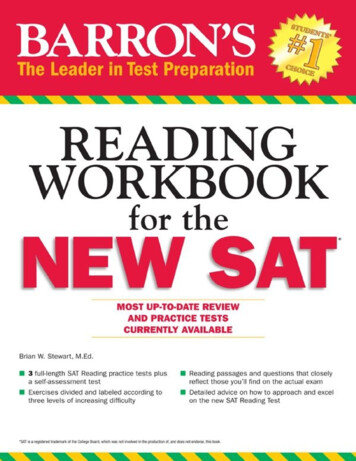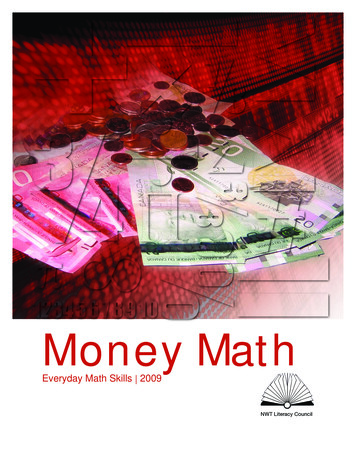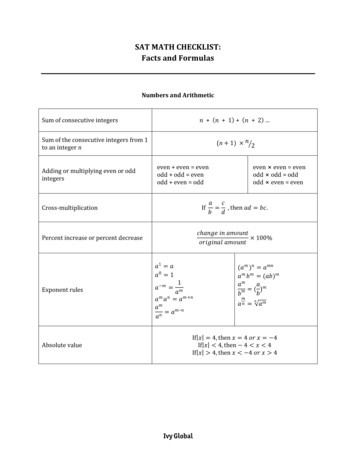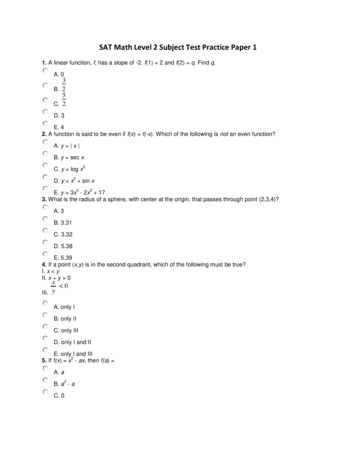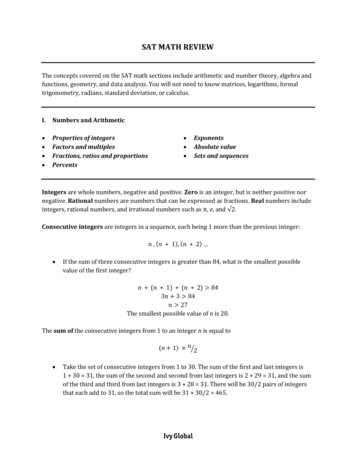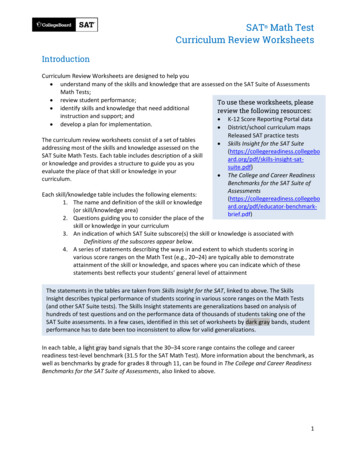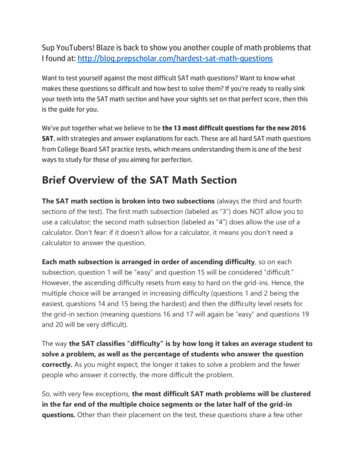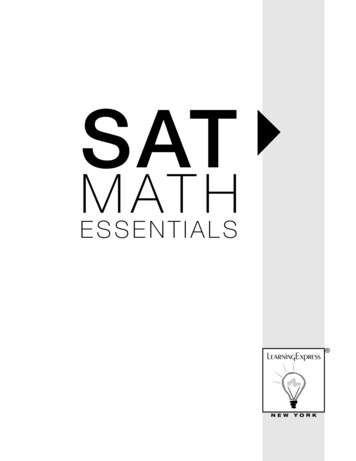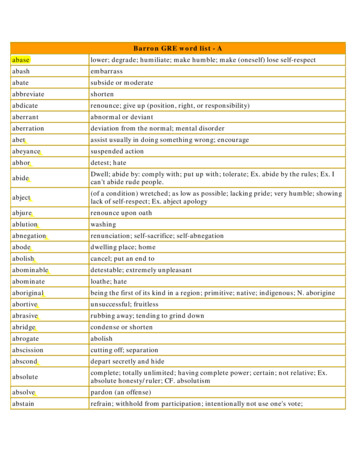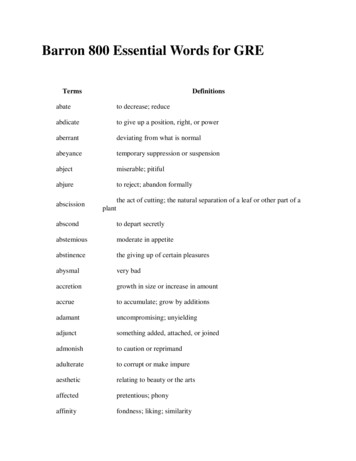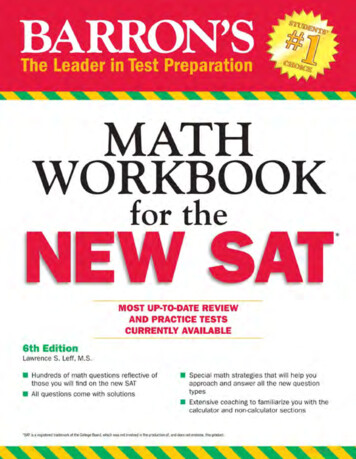
Transcription
DedicationTo Rhona:For the understanding,for the sacrifices,andfor the love
Copyright 2016, 2012, 2009, 2005, 2000, and 1996 by Barron’s Educational Series, Inc.All rights reserved.No part of this publication may be reproduced or distributed in any form or by any meanswithout the written permission of the copyright owner.All inquiries should be addressed to:Barron’s Educational Series, Inc.250 Wireless BoulevardHauppauge, New York 11788www.barronse duc.comeISBN: 978-1-4380-6811-4Publication date: June, 2016
ContentsPrefaceLEARNING ABOUT SAT MATH1 Know What You’re Up AgainstLesson 1-1Lesson 1-2Lesson 1-3Getting Acquainted with the Redesigned SATMultiple-Choice QuestionsGrid-In Questions2 SAT Math StrategiesLesson 2-1Lesson 2-2SAT Math Strategies You Need to KnowGuessing and Calculators on the SATTHE FOUR MATHEMATICS CONTENT AREAS3 Heart of AlgebraLesson 3-1Lesson 3-2Lesson 3-3Lesson 3-4Lesson 3-5Lesson 3-6Lesson 3-7Lesson 3-8Lesson 3-9Lesson 3-10Lesson 3-11Lesson 3-12Some Beginning Math FactsSolving Linear EquationsEquations with More Than One VariablePolynomials and Algebraic FractionsFactoringQuadratic EquationsSystems of EquationsAlgebraic InequalitiesAbsolute Value Equations and InequalitiesGraphing in the xy-PlaneGraphing Linear SystemsWorking with Functions4 Problem Solving and Data AnalysisLesson 4-1 Working with PercentLesson 4-2 Ratio and VariationLesson 4-3 Rate ProblemsLesson 4-4 Converting Units of MeasurementLesson 4-5 Linear and Exponential FunctionsLesson 4-6 Graphs and TablesLesson 4-7 Scatterplots and SamplingLesson 4-8 Summarizing Data Using Statistics5 Passport To Advanced MathLesson 5-1Lesson 5-2Lesson 5-3Lesson 5-4Lesson 5-5Lesson 5-6Rational ExponentsMore Advanced Algebraic MethodsComplex NumbersCompleting The SquareThe Parabola and Its EquationsReflecting and Translating Function Graphs
6 Additional Topics in MathLesson 6-1Lesson 6-2Lesson 6-3Lesson 6-4Lesson 6-5Lesson 6-6Reviewing Basic Geometry FactsArea of Plane FiguresCircles and Their EquationsSolid FiguresBasic TrigonometryThe Unit CircleTAKING PRACTICE TESTSPractice Test 1Practice Test 2How to Evaluate Your Performance on a Practice TestSOLUTIONS FOR TUNE-UP EXERCISES AND PRACTICE TESTSWorked out solutions for Chapters 3–6Answer Explanations for Practice Test 1Answer Explanations for Practice Test 2
PrefaceThis new edition of the Barron’s SAT Math Workbook is based on the redesigned 2016 SAT. It is organized arounda simple, easy-to-follow, and proven four-step study plan:STEP 1.STEP 2.STEP 3.STEP 4.Know what to expect on test day.Become testwise.Review SAT Math topics and SAT-type questions.Take practice exams under test conditions.STEP 1 KNOW WHAT TO EXPECT ON TEST DAYChapter 1 gets you familiar with the format of the test, types of math questions, and special directions that will appearon the SAT you will take. This information will save you valuable testing time when you take the SAT. It will also helpbuild your confidence and prevent errors that may arise from not understanding the directions on test day.STEP 2 BECOME TESTWISEBy paying attention to the test-taking tips and SAT Math facts that are strategically placed throughout the book, you willimprove your speed and accuracy, which will lead to higher test scores. Chapter 2 is a critically important chapter thatdiscusses essential SAT Math strategies while also introducing some of the newer math topics that are tested by theredesigned SAT.STEP 3 REVIEW SAT MATH TOPICS AND SAT-TYPE QUESTIONSThe SAT test redesigned for 2016 and beyond places greater emphasis on your knowing the topics that matter mostfrom your college preparatory high school mathematics courses. Chapters 3 to 6 serve as a math refresher of themathematics you are expected to know and are organized around the four key SAT Math content areas: Heart ofAlgebra, Problem Solving and Data Analysis, Passport to Advanced Math, and Additional Topics in Math (geometricand trigonometric relationships). These chapters also feature a large number and variety of SAT-type math questionsorganized by lesson topic. The easy-to-follow topic and lesson organization makes this book ideal for either independentstudy or use in a formal SAT preparation class. Answers and worked-out solutions are provided for all practiceproblems and sample tests.STEP 4 TAKE PRACTICE EXAMS UNDER TEST CONDITIONSPractice makes perfect! At the end of the book, you will find two full-length SAT Math practice tests with answer keysand detailed explanations of answers. Taking these exams under test conditions will help you better manage your timewhen you take the actual test. It will also help you identify and correct any remaining weak spots in your testpreparation.Lawrence S. LeffWelcome to Barron’s Math Workbook for the NEW SAT e-Book version!
Please note that depending on what device you are using to view this e-Book on, equations, graphs, tables, andother types of illustrations will look differently than it appears in the print book. Please adjust your deviceaccordingly.This e-Book contains hundreds of hyper links that will bring you to helpful resources and allow you to clickbetween questions and answers.
LEARNING ABOUTSAT MATH
1Know What You’re Up AgainstThis chapter introduces you to the test format, question types, and the mathematics topics you need to know for theredesigned 2016 SAT. Compared to prior editions of the SAT, the new SAT Places a greater emphasis on algebra: forming and interpreting linear and exponential models; analyzingscatterplots, and two-way tables. Includes two math test sections: in one section you can use a calculator and in the other section a calculator is notallowed. Does not deduct points for wrong answers.LESSONS IN THIS CHAPTERLesson 1-1 Getting Acquainted with the Redesigned SATLesson 1-2 Multiple-Choice QuestionsLesson 1-3 Grid-In Questions
LESSON 1-1 GETTING ACQUAINTED WITH THE REDESIGNED SATOVERVIEWThe March 2016 SAT test date marks the first administration of a redesigned SAT. The mathematics contentof the new version of the test will be more closely aligned to what you studied in your high school mathclasses. The redesigned SAT is a timed exam lasting 3 hours (or 3 hours and 50 minutes with an optionalessay).What Does the SAT Measure?The math sections of the new SAT seek to measure a student’s understanding of and ability to apply those mathematicsconcepts and skills that are most closely related to successfully pursuing college study and career training.Why Do Colleges Require the SAT?College admissions officers know that the students who apply to their colleges come from a wide variety of highschools that may have different grading systems, curricula, and academic standards. SAT scores make it possible forcolleges to compare the course preparation and the performances of applicants by using a common academic yardstick.Your SAT score, together with your high school grades and other information you or your high school may be asked toprovide, helps college admission officers to predict your chances of success in the college courses you will take.How Have the SAT Math Sections Changed?Here are five key differences between the math sections of the SAT given before 2016 and the SAT for 2016 andbeyond: There is no penalty for wrong answers.Multiple-choice questions have four (A to D) rather than five (A to E) answer choices.Calculators are permitted on only one of the two math sections.There is less emphasis on arithmetic reasoning and a greater emphasis on algebraic reasoning with more questionsbased on real-life scenarios and data.New Math TopicsBeginning with the 2016 SAT, these additional math topics will now be required: Manipulating more complicated algebraic expressions including completing the square within a quadraticexpression. For example, the circle equation x2 y2 4x 10y 7 can be rewritten in the more convenientcenter-radius form as (x 2)2 (y 5)2 36 by completing the square for both variables. Performing operations involving the imaginary unit i where i . Solving more complex equations including quadratic equations with a leading coefficient greater than 1 as well asnonfactorable quadratic equations. Working with trigonometric functions of general angles measured in radians as well as degrees.Table 1.1 summarizes the major differences between the math sections of the previous and newly redesigned SATs.TIPIf you don’t know an answe r to an SAT Math que stion, make an e ducate d gue ss! The re is no point pe nalty for a wrong answe r
on the re de signe d SAT. You ge t points for the que stions you answe r corre ctly but do not lose points for any wrong answe rs.Table 1.1 Comparing Old and New SAT MathTe st Fe atureO ld SAT Math (be fore 2016)Re de signe d SAT Math (2016 and afte r)Test T ime70 minutes80 minutesNumber of sectionsT hreeTwo: one 55-minute calculator section and one25-minute no-calculator sectionNumber of questions54 44 multiple-choice 10 grid-in58 45 multiple-choice 13 grid-inCalculatorsAllowed for each math sectionPermitted for longer math section onlyPoint penalty for a wrong answer?YesNoMultiple-choice questions5 answer choices (A to E)4 answer choices (A to D)Point valueEach question counts as 1 point.Each question counts as 1 point.Math content Topics from arithmetic, algebra,and geometry Only a few algebra 2 topics Not aligned with college-boundhigh school mathematics curricula Greater focus on three key areas:algebra, problem solving and dataanalysis, and advanced math More algebra 2 and trigonometrytopics, more multistep problems,and more problems with real-worldsettings Stronger connection to collegebound high school mathematicscoursesWhat Math Content Groups Are Tested?The new test includes math questions drawn from four major content groups: Heart of Algebra: linear equations and functions Problem Solving and Data Analysis: ratios, proportional relationships, percentages, complex measurements,graphs, data interpretation, and statistical measures Passport to Advanced Math: analyzing and working with advanced expressions Additional Topics in Math: essential geometric and trigonometric relationshipsTable 1.2 summarizes in greater detail what is covered in each of the four math content groups tested by the redesignedSAT.Table 1.2 The Four SAT Math Content GroupsMath Conte nt GroupHe art of Alge braKe y Topics Solving various types of linear equations Creating equations and inequalities to represent relationships betweenquantities and to use these to solve problems Polynomials and Factoring Calculating midpoint, distance, and slope in the xy-plane Graphing linear equations and inequalities in the xy-plane Solving systems of linear equations and inequalities
Recognizing linear functions and function notationProble m Solving and Data Analysis Analyzing and describing relationships using ratios, proportions, percentages,and units of measurement Describing and analyzing data and relationships using graphs, scatter plots, andtwo-way tables Describing linear and exponential change by interpreting the parts of a linear orexponential model Summarizing numerical data using statistical measuresPassport to Advance d Math Performing more advanced operations involving polynomial rationalexpressions, and rational exponents Recognizing the relationship between the zeros, factors, and graph of apolynomial function Solving radical, exponential, and fractional equations Completing the square Solving nonfactorable quadratic equations Parabolas and their equations Nonlinear systems of equations Transformations of functions and their graphsAdditional Topics in Math Area and volume measurement Applying geometric relationships and theorems involving lines, angles, andtriangles (isosceles, right, and similar). Pythagorean theorem, regular polygons,and circles Equation of a circle and its graph Performing operations with complex numbers Working with trigonometric functions (radian measure, cofunction relationships,unit circle, and the general angle)What Types of Math Questions Are Asked?The redesigned SAT includes two types of math questions: Multiple-choice (MC) questions with four possible answer choices for each question. Student-produced response questions (grid-ins) which do not come with answer choices. Instead, you must workout the solution to the problem and then “grid-in” the answer you arrived at on a special four-column grid.How Are the Math Sections Set Up?The redesigned SAT has two math sections: a section in which a calculator is permitted and a shorter section in which acalculator is not allowed. The 55-minute calculator section contains 38 questions. Not all questions in the calculator section require orbenefit from using a calculator. The 25-minute no-calculator section has 20 questions.Table 1.3 Breaking Down the Two Math SectionsThe Two Type s of Math Se ctions
Calculator math section55 minutes30 MC 8 grid-ins 38 questionsNo-calculator math section25 minutes15 MC 5 grid-ins 20 questionsTable 1.4 summarizes how the four math content areas are represented in each of the math sections.Table 1.4 Number of Questions by Math Content AreaHow Are the SAT Math Scores Reported?When you receive your SAT Math score, you will find that your raw math test score has been converted to a scaledscore that ranges from 200 to 800, with 500 representing the average SAT Math score. In addition, three math testsubscores will be reported for the following areas: (1) Heart of Algebra, (2) Problem Solving and Data Analysis, and(3) Advanced Math.The Difficulty Levels of the QuestionsAs you work your way through each math section, questions of the same type (multiple-choice or grid-in) graduallybecome more difficult. Expect easier questions at the beginning of each section and harder questions at the end. Youshould, therefore, concentrate on getting as many of the earlier questions right as possible as
Welcome to Barron’s Math Workbook for the NEW SAT e-Book version! Please note that depending on what device you are using to view this e-Book on, equations, graphs, tables, and other types of illustrations will look differently than it appears in the print book. Please adjust your device accordingly. This e-Book contains hundreds of hyper links that will bring you to helpful resources and .
